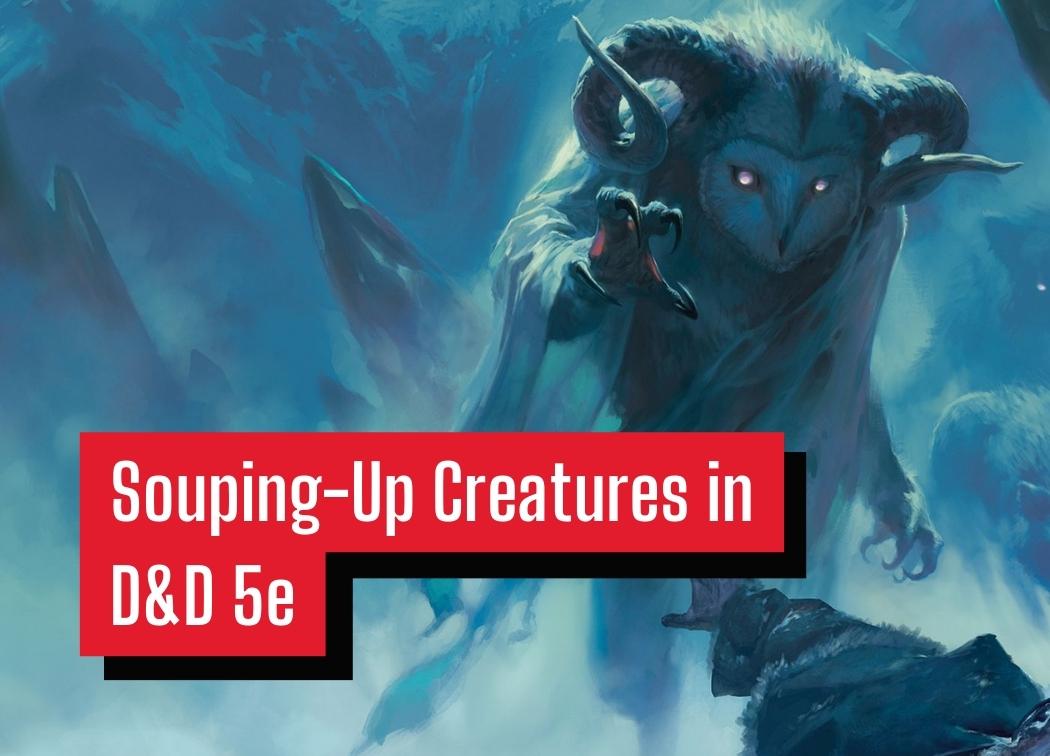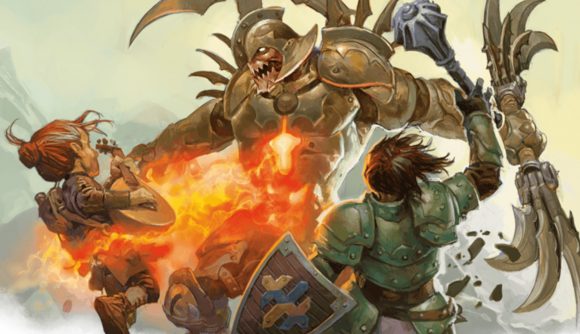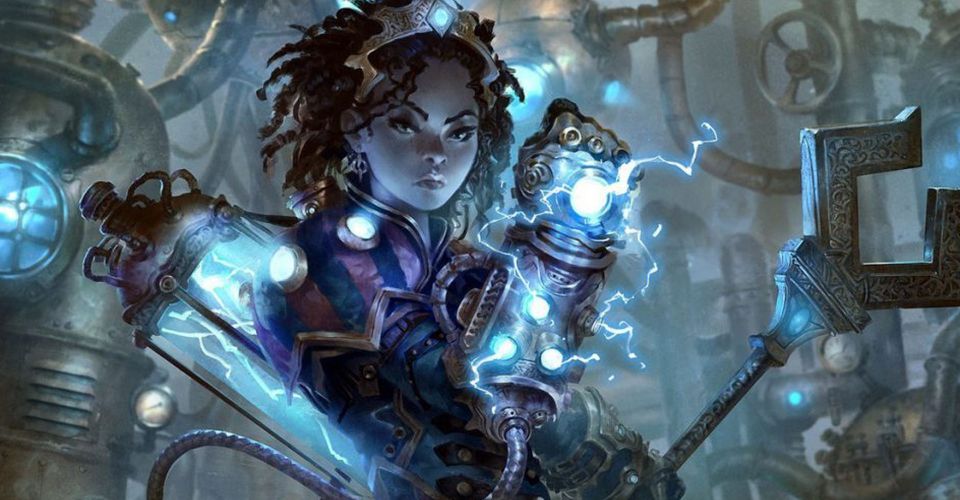Souping-Up Creatures in D&D 5e

A common, reoccurring theme or mechanic in RPGs is that as your character(s) level up and progress through the story, the creatures get tougher. Yet you’ll often face off against the same creatures as you did when you first started the game. Albeit, a more powerful variant of those creatures.
The green slime becomes a purple slime. Those goblins become goblin warlords. The rattata becomes a raticate.
You get the idea.
D&D 5e has a similar pattern. Creatures in the monster manual have variants or higher-powered counterparts published alongside them or in other sourcebooks. Yet it’s a limited assortment, and understandably so. It’s asking for a lot of hours from WotC game designers to design a suitable variant creature for every low-CR creature they pump out.
Yet, there are plenty of times where I want to use a low-CR creature for an adventure well past their capabilities. I just had a session this last week where I sent the party on a Monster Hunter-inspired hunt for a superpowered Owlbear. It was awesome, but I had to homebrew the creature.
I swear I see (and have given) this advice many times. “Beef up a low-CR creature to give the party a familiar, but still challenging foe!” It’s great advice, but it doesn’t give less experienced DMs much to work with.
So, let’s talk about my process for creating souped-up creatures in 5e!

Copying is the Best Form of Flattery
First thing’s first. You don’t get bonus points for building a homebrew creature for your home game from the ground up. Whenever I’m souping up a creature I always use the creature’s original statblock as a foundation for a couple of reasons.
- Doing so keeps the creature’s flavors in-tact
- It’s way easier to scale up a creature’s statblock rather than reinvent the wheel
Souping up doesn’t mean completely building a new creature from the ground up. It means we’re taking something old and breathing new life into it.
Oh also, NEVER be afraid to use a creature at the CR you’re adjusting to as a reference. I still do this all the time to ensure my creature’s new values are sensible. Hell, you can straight-up lift elements of different creatures at that CR. Who’s going to stop you?
What’s Your Design Goal?
The first step when homebrewing is to first ask yourself what your goals are with your creation. What are you trying to create or accomplish by creating this? What niche does it fit? How do you envision playing it in-game?
This doesn’t have to be anything formal or have a certain structure to it. It’s an exercise you already subconsciously do. I know I did years ago.
Yet it’s a super important first step. In doing so, you’ll hone in on what areas you’ll need to focus on fine-tuning the creature to bring it up to snuff.
Here are a few design goal examples that I often use for this flavor of homebrewing.
Higher-CR Minions
Let’s say you’re building a campaign focused on a certain creature or type of creature. Maybe gnolls like this example by Sly Flourish. While you certainly wouldn’t want the party to fight gnolls every single combat, you may want to throw them in a bit more often than you’re able to with the official statblocks allow.
You need to beef up some gnolls. This comes with raising their CR. However, raising CR isn’t enough. You need to bring their statblock up to par as well!
A Big New Boss
In my personal experience, I’ve found that most of the time I’m souping up a low-CR creature’s statblock to turn them into a boss creature for a high-stakes boss fight.
It’s a challenge to create a respectable 1 vs. 4-6 boss fight due to 5e’s action economy, but if you slap on some legendary and lair actions you can make a respectable foe for the party to square off against.
You can also throw on a Bonus action or a Reaction. Regardless, creating a boss requires more than just beefing up the creature’s original statblock. You need to add some goodies alongside it to make it worthwhile.

A Brand-New Playstyle
A few changes or additions to a statblock can breathe new life into a creature. Giving a creature extra movement or a unique form of movement gives them new mobility and positioning tools to play with. Turning a basic melee combatant into a hit-and-run menace.
Adding spellcasting is one of the more obvious and potent ways of spicing up a creature’s statblock to give them a new playstyle. WotC does this in official statblocks all the time. Check out the drider for an example of this.
Sometimes you don’t want something much more powerful, you just want something a little more powerful, but new.
Let’s Soup this Baby Up!
Now that we have an idea of what we want to do, let’s start putting the pieces together. Here are a few ways we can go about souping up our creatures.
CR Tweaks
This involves playing with the numbers. Increase the creature’s ability scores, AC, HP, damage, etc. to match what you need. Keep in mind too that as you increase CR, their proficiency bonus increases as well so their to-hit bonus will also scale with their heightened CR.
Your best resource for determining a creature’s CR is page 274 of the DMG. This gives you a ton of information in a neat table such as what a creature of a certain CR’s average damage per round (DPR) and base defenses should be.
Keep in mind that this isn’t a set number. CR is divided into two parts: offensive CR and defensive CR. A CR 10 creature could have CR 12 offenses and CR 8 defenses for example.
Another tip is to soup up the creature with respect to your party. For example, if your party is stacked with ranged combatants give the creatures a ranged Multiattack to answer the party’s attacks, or give them enhanced mobility to reach their foes quicker and avoid being kited to death.
You can also do all this to drop creatures down a few CR. Although I rarely find the need to do so. Plus, I find it more difficult to balance properly. Regardless, it’s possible. Simply use the same advice, but instead of increasing values, decrease them.
Add New Traits and Actions
My favorite method of powering up a creature is to give it brand new toys. It’s a great way to give them some more power, sure, but it also makes them more fun to pilot as a DM. I like new toys!
Don’t forget about Bonus actions and Reactions! Giving a creature reliable or semi-reliable usage of these is a huge boon. It helps level the action economy disparity between the party and creatures. Plus, it’s a great way to tack on some extra survivability, mobility, or utility.
Even adding “boring” traits like Magic Resistance can make a huge difference in a creature’s combat capabilities.
New, unique actions are a great way to give creatures new weapons to shore-up strategic weak spots in their kit. Even a simple, reliable ranged attack option can make a huge difference in combat.
However, my favorite actions to add are high-powered rechargeable actions. Due to their recharge rate, these actions are unreliable. Ergo, you can put some extra power behind them and it’s still a fair shake. For example, a breath weapon or other AoE attack can give a creature a huge chunk of burst damage to smack the whole party with.
Don’t forget about crowd control. Restraining, paralyzing, or applying any other condition to the party, AoE or single target, can be more valuable than straight-up damage.
Resistances, Saving Throw Proficiencies, and Immunities
These aren’t the flashiest additions to a statblock, but they are potent tweaks. Particularly for boss creatures.
Reducing or negating certain types of damage can force the party to switch up their usual tactics and bread-and-butter spells against a newfound super-powered foe.
Adding a few condition immunities can prevent a boss from getting perma-CC’d by spellcasters, making it a dangerous encounter for the whole party.
A couple of high-value saving throw proficiencies make a huge difference. They’re fairer than adding a condition immunity which flat-out negates certain types of CC as it still requires the creature to succeed on a saving throw. However, they provide a wider range of protection from conditions due to giving the creature a higher chance of making certain saves.
Legendary Actions & Lair Actions
These additions are often reserved for boss creatures. Creatures that need an action economy boost to help bridge the gap between PC and creature.
Although, you could add them to any creature that’s going to be going against the party at a numbers disadvantage.
I’ve written an article in the past on how these work, so I won’t go into detail about their mechanics here. Instead, let’s talk about what you should aim for when giving a creature these actions.
Extra damage is an obvious and easy add. A simple 1 cost extra use of one of the creature’s basic attacks is a staple for legendary action design. However, you can also throw in a unique attack that varies in power (and legendary action cost).
Crowd and battlefield control can be baked into the creature’s legendary actions outright, or in their lair actions. These are valuable actions as they allow your creature to keep dishing-out damage, but still provide a hearty chunk of utility.
Movement is a less appreciated addition, but a powerful one during an encounter. Give the creature an extra move, a teleport, or any other tool to reposition with and you can give them some extra breathing room in combat. You can even tie in a condition where the creature moves without provoking opportunity attacks, although this should raise the action’s cost.
Be creative. Legendary and Lair actions are meant to break the game a bit. They’re supposed to be high-value. They’re for a boss creature after all!
Example: My Souped-Up Owlbear

You can see the owlbear’s statblock under the hood of the demon-touched owlbear. Its stat spread keeps the same pattern, it still has Keen Sight and Smell, and it has the same Multiattack combo. Albeit, everything is souped up to a CR 10 threshold as it’s supposed to be a challenging boss creature for a 6 PC level 4 party.
In my campaign, I’ve ripped off the Apex Monsters from Monster Hunter. In a land with latent leftover demonic magic, some creatures have inexplicably (no spoilers lads 😉 ) mutated. Every demon-touched creature becomes more powerful than their non-mutated counterparts, plus they gain a couple of common traits:
- +2 AC
- Magic Resistance
- Magic Weapons
- Regeneration
- Legendary Actions (possibly Mythic Actions too!)
The +2 AC might change, but the rest feels good thematically and gives me some base design features to build off of for each new demon-touched creature. It gives every creature a heightened defensive foundation to work with, particularly against ranged spellcasters which most of these beast or beast-like creatures have issues with.
I also made two lair actions, but the party lured my precious baby out of its lair so I didn’t get to use them. Regardless here they are:
Cave-In. The owlbear roars, creating reverberations which cause a minor cave-in in a 15 ft. cone originating from the owlbear. Roll 1d8 to choose a cardinal direction (1 being North, 2 Northeast, etc.). Any creature standing within that space must make a DC 15 Dexterity saving throw or take 2d6 bludgeoning damage and be knocked prone. That area is now considered difficult terrain.
Perch. The owlbear leaps atop the closest rock within 20 ft. of its current position. This movement does not provoke opportunity attacks.
Perch is fine I think. It’s just your standard “reposition without provoking opportunity attacks” boss move. Cave-in would’ve been overkill considering the party barely made it out of the encounter alive. Although to be fair, they did this quest a whole level earlier than intended.
Mechanically I’m interested to see how it’d play out. Its damage is a decent chunk against level 3-5 PCs, but the real danger is the constantly-shrinking battlefield. The party is already outpaced by the demon-touched owlbear, shrinking the battlefield gives it a better advantage positioning-wise.
Conclusions
Souping up creatures is a fun design exercise. It’s a great way to learn how 5e creatures are designed and how different statblock elements impact their play during game time.
It’s also a great way to throw in old favorites to a campaign for lore reasons. It’s more work than reskinning an equivalent creature, but I find that the time spent is worth it. Provided that you have the time to do so of course.
I love taking a creature into my shop and adding brand-new toys and features to play with in-game. It’s one of my favorite things to do when prepping for my home campaigns. Hopefully, this breakdown of my process helps you too!

Those Lair Action sound more like Legendary Actions, since the Lair itself doesn’t actually respond to the owlbear’s magic. Especially with that Perch action.
I recently took inspiration from Heroes of Might and Magic III, which has an upgraded form of every unit (minotaur king, harpy hag, royal griffin, chaos hydra, etc.), and it’s been a lot of fun to put one of these in a group of the lesser ones when the players encounter them. Even just skinning one enemy differently and giving it max or double hit points really makes it seem more interesting.